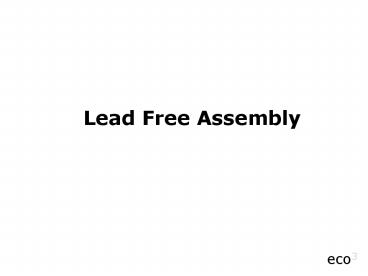Lead Free Assembly - PowerPoint PPT Presentation
1 / 22
Title:
Lead Free Assembly
Description:
The biggest impact of the RoHS Directive for most companies will be the removal ... Materials and processes used ... degradation and thermolysis. delamination ... – PowerPoint PPT presentation
Number of Views:126
Avg rating:3.0/5.0
Title: Lead Free Assembly
1
Lead Free Assembly
2
- The biggest impact of the RoHS Directive for
most companies will be the removal of lead from
most electrical and electronic products
3
Why are there Concerns?
- Lead is widely used in electronics assembly
- New alloys behave differently to conventional
solders - Materials and processes used will have to change
- Products will need to be retested and requalified
- Designs may need to change
- Older equipment may have to be upgraded or
replaced - Training
- Component availability and identification
4
What are the Alternatives?
- Replace conventional solder with conductive
adhesives only possible in limited applications - Use alternative lead-free materials for
- PCB etch resists
- solderable finishes on circuit boards
- metallisation on components
- device assembly
- soldering
5
Alternative Lead Free Solders
- Many alternative alloys have already been
proposed and evaluated - None offer all the processing benefits of
tin-lead solder - But viable alternatives are available
- Alloys proposed for widespread use have melting
points above tin-lead e.g. SnAgCu and SnCu
6
Alternatives to Tin Lead Solder
7
Areas of Concern due to Higher Temperatures
- Substrate stability mechanical and thermal
- Component degradation/malfunctioning
- Fluxes and cleaning
- Effects on other organic materials
- Equipment capabilities - reflow profiles,
inerting etc - Inspection - different criteria
- Rework - which alloy to use
- Longer term reliability related issues
- Design implications
8
PCB Laminates and Substrates
- A wide range of laminate types is used, from
paper-filled phenolics to high Tg materials - Laminates are organic materials and could be
susceptible to - warping
- degradation and thermolysis
- delamination
- failure of interconnects in multilayer plated
through holes
9
PCB Solderable Finishes
- Tin-lead HASL board finishes will not be possible
- Alternatives are well established and include
tin, nickel-gold, silver, OSP etc - Some issues e.g.lead-free solders do not wet OSP
coated copper as well as tin-lead - Possible to use lead-free HASL
10
Lead Free Component Finishes
- Component leads need to be lead-free
- Recent shortage of such components but the
situation is now improving - There are several possible lead finishes
- Concerns over tin whiskering - suppliers working
to develop whisker free matte tin processes
11
Possible Problems with Lead Free
Tin Whiskering
12
Possible Problems with Lead Free
Fillet lifting
13
Possible Problems with Lead Free
Tombstoning
14
Possible Problems with Lead Free
Solder balling
15
Possible Problems with Lead Free
Other heat related issues
16
Reflow Soldering
- Higher melting point solders require increased
reflow temperatures - Peak reflow temperatures for tin-lead solder
exceed the melting point by 30 - 40C - Typical peak reflow temperatures for alloys
melting around 215C may be 230 - 240C - Reflow temperatures may only exceed melting point
by 10 - 25C
17
Soldering Equipment
- Capability of existing equipment older reflow
ovens may not have as good temperature control as
modern ones - Replacing equipment may be a significant cost to
SMEs - Safety issues running at higher reflow
temperatures - Higher temperatures mean higher energy costs
18
Rework and Repair
- Concerns over component rework due to higher
temperatures - Important issue for complex components such as
BGAs where a larger energy input is required - How will the alloy used be identified by the
repairer? - There can be incompatibilities between alloys
leading to reliability issues
19
Lead Free is already Established
- Successful commercialisation of many products
- Lead-free telephones, televisions and keyboards
are all now available in Europe - Japanese committed to lead-free
- with or without legislation
- Matsushita made all electronic components
- completely lead-free by April 2003
20
Possible Cost Implications
SourceFabfile Online Report 10th October 2004
21
Summary
- Lead-free alloys require elevated soldering
temperatures - The influence of higher temperatures needs to be
understood and allowances made - Many of the identified issues are not as serious
as initially anticipated - It takes time and effort to develop new robust
lead-free assembly processes!
22
Questions?































